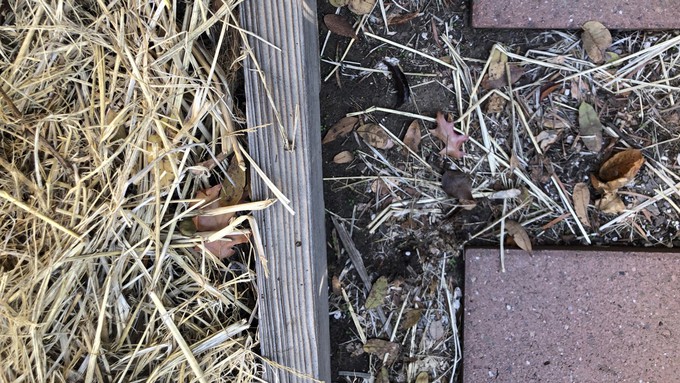
Healthy soil is crucial for our plants and our environment

Where's the soil? It's alive under there: The raised bed is covered with straw mulch, and the ground soil is allowed to be "littered" with straw and leaves. The stepping stones keep the gardener on the path, avoiding compaction of planting areas. Kathy Morrison
Any gardener who spends time poring over catalogs, debating plant varieties and choosing seeds, yet ignores the importance of the garden’s soil, is limiting the plants’ eventual success.
Soil isn’t just dirt. It’s alive with organic matter and multitudes of organisms, in addition to being about 45 percent minerals, 25 percent water and 25 percent air. Healthy soil gives plants their best life, and every gardener should be well-acquainted with their microclimate’s soil.
During a time of year when gardening activity calms down, California chooses to celebrate Healthy Soils Week, via the California Department of Food and Agriculture and the University of California Agriculture and Natural Resources division, which includes the UCCE Master Gardener Program. The celebration runs through Friday, but the resources are available year-round.
New this year are a couple of excellent 45-minute talks that were presented live on Facebook and now are available on YouTube:
– “Healthy Soil: In nature, sometimes less is more,” by Mike Corby, a UCCE master gardener in Contra Costa County. He discusses the components of soil and why each is crucial. He also explains why it’s important not to disturb the soil environment too much, by tillage, compaction or – here’s a surprise – pulling out the roots of spent plants (such as tomatoes.) Better to cut them off at ground level and let the roots compost naturally in the soil environment, he says.
– “Harnessing the Magic of the Soil Food Web: Turning Dirt into Gold,” presented by Kit Veerkamp, a landscape architect and UCCE master gardener in El Dorado County. She notes how a healthy soil food web controls disease and keeps pathogens in check. She discusses composting and has some interesting things to say about the harm that weed cloth can cause.
I also recommend "Tips to Keep Your Garden Soil Healthy,” a talk from 2020 presented by Dustin Blakey, the Inyo/Mono counties' farm adviser and master gardener program coordinator. He notes that a huge percentage of gardeners load up their soils with excess amendments and nutrients, trying to find the perfect "recipe" for, say, their tomatoes or their cucumbers. "Focus on improving garden soil, and don't fuss about a single crop," he advises.
More soil resources:
This page from UCANR, Healthy Soils - Basics, has lots of great information, including a quick quiz to test how much you know about soils. Links there provide hours of reading material on soil, but here’s a list from that page with a quick summary of what healthy soil is and does:
A healthy soil will:
Clicking on the For Homes & Gardens tab on that page brings up more specific and very useful information for the home gardeners, covering topics such as common home soil problems, practices to improve home soil; soil pH and how to test it, soil texture, and amendments.
A week hardly seems enough time each year to cover the topic of healthy soils. But it’s worth exploring during the dark days of winter – your plants will appreciate it this spring.
Some of our winter garden topics you might have missed:
December rose care: Start pruning now
Garden checklist for week of Dec. 4
How cold is too cold for my citrus tree?
Comments
0 comments have been posted.Sacramento Digs Gardening to your inbox.
Sites We Like
Garden Checklist for week of May 12
Get your gardening chores and irrigation done early in the day before temperatures rise.
* Plant, plant, plant! It’s prime planting season in the Sacramento area. Time to set out those tomato transplants along with peppers and eggplants. Pinch off any flowers on new transplants to make them concentrate on establishing roots instead of setting premature fruit.
* Direct-seed melons, cucumbers, summer squash, corn, radishes, pumpkins and annual herbs such as basil.
* Harvest cabbage, lettuce, peas and green onions. This heat will cause leafy greens and onions to flower; pick them before they bolt.
* In the flower garden, direct-seed sunflowers, cosmos, salvia, zinnias, marigolds, celosia and asters.
* Plant dahlia tubers. Other perennials to set out include verbena, coreopsis, coneflower and astilbe.
* Transplant petunias, marigolds and perennial flowers such as astilbe, columbine, coneflowers, coreopsis, dahlias, rudbeckia and verbena.
* Keep an eye out for slugs, snails, earwigs and aphids that want to dine on tender new growth.
* Feed summer bloomers with a balanced fertilizer.
* For continued bloom, cut off spent flowers on roses as well as other flowering plants.
* Got fruit trees? If you haven't already done so, thin orchard fruit such as apples, peaches, pears, pluots and plums before they grow too heavy, breaking branches or even splitting the tree. Leave the largest fruit on the branch, culling the smaller ones, and allow for 5 to 6 inches (or a hand's worth) between each fruit.
* Thin grape bunches, again leaving about 6 inches between them. For the remaining bunches, prune off the "tail" end, about the bottom third of the bunch, so that the plant's energy is concentrated in the fruit closest to the branch.
* As spring-flowering shrubs finish blooming, give them a little pruning to shape them, removing old and dead wood. Lightly trim azaleas, fuchsias and marguerites for bushier plants.
* Add mulch to the garden to help keep that precious water from evaporating. Mulch also cuts down on weeds. But don’t let it mound around the stems or trunks of trees or shrubs. Leave about a 6-inch to 1-foot circle to avoid crown rot or other problems.